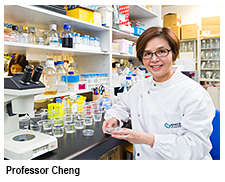CityU plans advanced equipment purchase with RGC grant
Two state-of-the-art pieces of research equipment will be purchased by City University of Hong Kong (CityU) in collaboration with other local universities thanks to a grant worth over HK$12 million from the Collaborative Research Fund launched by the Research Grants Council (RGC).
The atom probe tomography (APT) and a light-sheet microscope (LSM) will be used to study the composition and structural morphology of nanomaterials as well as to monitor cellular developments in a living zebrafish embryo. Both pieces of equipment promise to make breakthroughs in the research of new materials and organ regeneration.
Professor Liu Chain-tsuan, University Distinguished Professor at CityU, together with scientists from four local universities will use HK$10 million from the RGC grants to purchase the 3D (3 dimensions) APT (LEAP 5000) from CAMECA in the US. The total cost of the micro-analytic tool will be as high as HK$22 million. In addition, a 3D-APT centre will be established at CityU.
An APT can be used to analyse nanoscale particles as small as 0.3 to 0.5 nanometres through 3D imaging technology. It allows materials scientists to know precisely the size, shape, composition, and structure of particles. This information enables scientists to improve the microstructures and properties of advanced materials and develop new materials to meet the needs of today’s society.
“For example, we have to control the structural features to make Fe-based alloys hard but not brittle. Only when we know accurately the size and morphology of the particles can we control the structure and properties,” said Professor Liu.
“By knowing precisely the composition of particles, we can understand the physical and chemical properties, the effects of the particle composition on physical and mechanical properties of advanced materials, as well as the shortcomings in the structure,” he continued.
Professor Liu said he would use the APT to study metallic materials such as nano iron and steel, refined titanium alloys, and heterogeneous metallic glasses.
Professor Liu, a renowned scientist in the area of advanced structural materials, is a Member of the US National Academy of Engineering, a Foreign Member of the Chinese Academy of Engineering, and a member of Academia Sinica Taiwan. He worked at the Oak Ridge National Laboratory in the US for many years.
Professor Cheng Shuk Han of CityU’s Department of Biomedical Sciences, together with scientists from two universities, will use $2.4 million of the RGC grants to purchase the LSM.
The LSM tracks the positions of different types of cells and produces 3D fluorescence images over time in the transparent zebrafish embryo. This process enables researchers to reconstruct the paths of cell migration during embryonic development through different terrains of the extracellular matrix.
“We will use the LSM to map out the routes of single and cohort cell migration in developing embryos that are immobilised within a transparent cylinder,” said Professor Cheng. “While the container is kept spinning, the microscope can monitor cell migration over time from various angles.”
Professor Cheng is known for the successful translation of her work using the medaka fish larvae for drug screening and pollutant testing. Two CityU alumni who have applied her technology to food and cosmetics testing recently won the Grand Prix at the 43rd Geneva International Exhibition of Inventions.
With the aid of this equipment, CityU and the other universities in Hong Kong will carry out over 10 collaborative research projects on new materials and cells.

